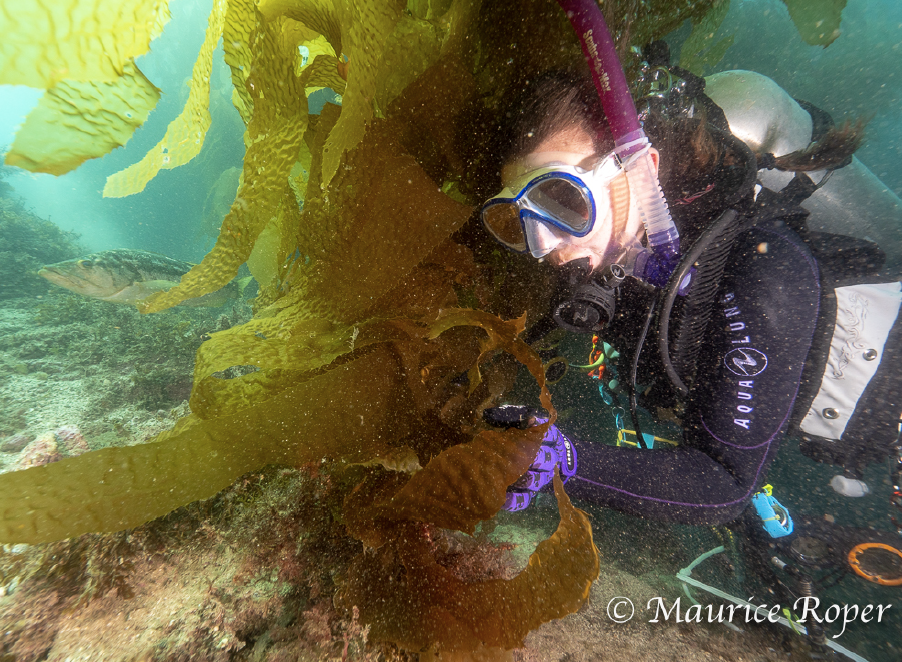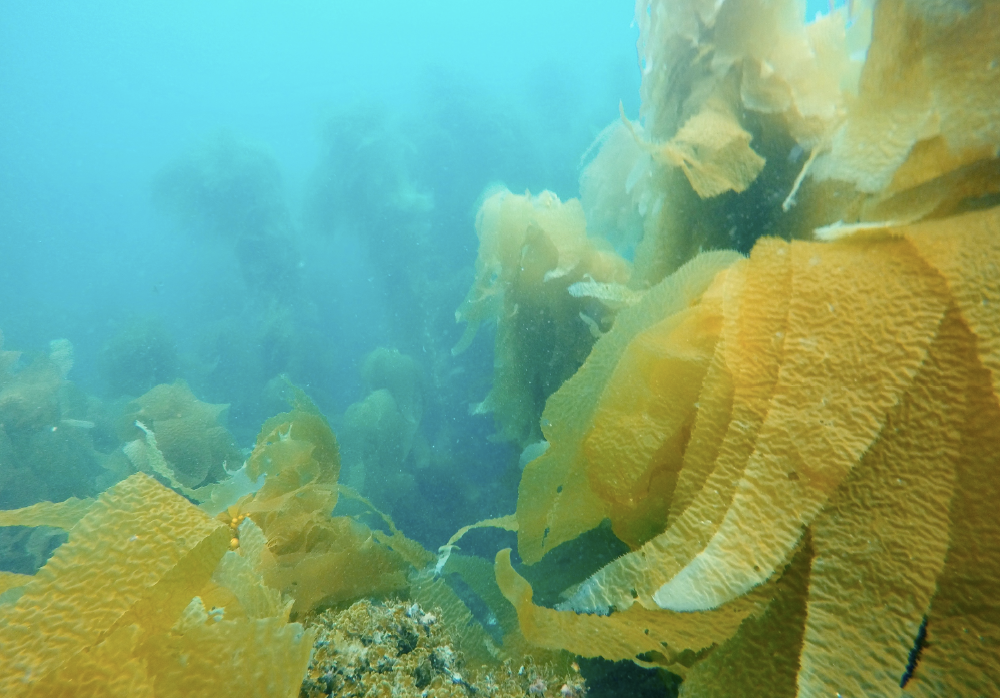By: Ann Bishop
Underneath blue water that surrounds Catalina Island and the green waves that lap at the shores of USC’s Wrigley Institute for Environmental Studies the sea-scape is changing. Giant brown kelp (Macrocystis pyrifera), considered ubiquitous with California’s coast, is again going through a transformation. During the 2015/16 El Niño it all but disappeared from Catalina’s coves due to warm, nutrient poor water and storms. It was then replaced by a thicket of the invasive species Sargassum horneri, which took up valuable space on the rocky reefs and made it difficult for the remaining kelp to find a home when the cold and nutrient rich waters returned.
M. pyrifera is one of the most valuable and visible species of seaweed known to our coastal communities. Because of the habitat it creates, the amount of life it supports is astounding: crabs, lobsters, sea slugs, fish, seals, and so many other species rely on kelp forests. This wildlife is attractive to local and international outdoor enthusiasts. It serves to support the local ecology and economy. More recently, it has even gained value as a potential bio-fuel source, which may support a transition to a greener way of life in the face of climate change.
With how intertwined California is with its kelp forests, it is important to understand how marine heat waves, invasive species, and other markers of our changing oceans interact with foundation species like M. pyrifera. This has been the broad focus of my research. As a fortunate two-time recipient of the USC Wrigley Fellowship, I have been following kelp forests on the West-End of Catalina as they face these stressors over the course of fourteen months. During this time, I have been conducting monthly surveys to observe the interactions of populations and demographics of M. pyrifera and S. horneri. This included collecting samples to understand how seasonality and temperature change their reproductive potential and, growing them in the lab to understand how temperature and nutrients impact growth at their early life stages.
The best and most fascinating part of this research has been watching the seascape of algae on the rocky reefs change. All sites had thriving kelp forests before the 2015/16 El Niño, and at the beginning of this study were either dominated by M. pyrifera or S. horneri. These stark contrasts could be found on either side of Big Fisherman’s Cove. By the lab’s intake pipes, a lush forest full of large fish dominated last summer and on the opposite side was a sunny golden-brown meadow of S. horneri and understory seaweeds.
As the warm waters of fall fell into the cove, the kelp fronds became colonized by invertebrates and fell away from the holdfasts. The S. horneri continued to put on fronds and began to look like large ferns, with the occasional individual bolting to tower above its peers to take advantage of the late sun to reproduce and drop its propagules.
In winter, the intense wind, waves, and storms tore out most of the towering kelp fronds, but surprisingly left kelp holdfast behind. These holdfasts invested heavily in reproductive fronds producing millions of spores to drift in the current. By February they were looking ragged and the sargassum was becoming a dense thicket- individuals towering over 6ft! It was so dense the sea floor was in a permanent twilight.
Spring however showed some surprising changes. The site that was notable by kelp’s absence began to have small juvenile kelps fighting for a foothold and starting to grow. And, where there had been no sargassum before, there was an understory mixing with in the taller kelp. Then, with the arrival of summer, the S. horneri finished their life cycle leaving behind tiny fern-like juveniles of the next generation. The tiny new kelp that survived the sargassum thickets shot new fronds to the surface, so quickly it seemed to happen overnight! Exhibiting just how quickly (2-3ft a day) it can grow under near ideal conditions and just how persistence this species is.
In the course of the year the kelp disappeared, re-appeared, and even expanded its territory. The S. horneri would flourish, dominate, and then retreat to the understory. The recovery of the kelp forests post-El Niño may be slow, but M. pyrifera’s adaptability and persistence is hopefully a sign that while kelp forests may change with the climate, they will continue to be a fixture of the coastline for a few years yet.



